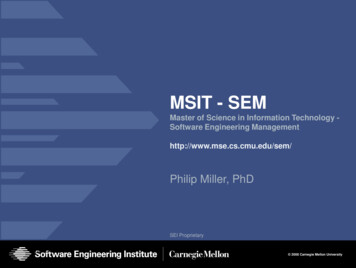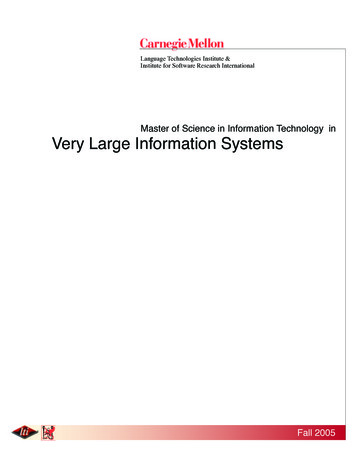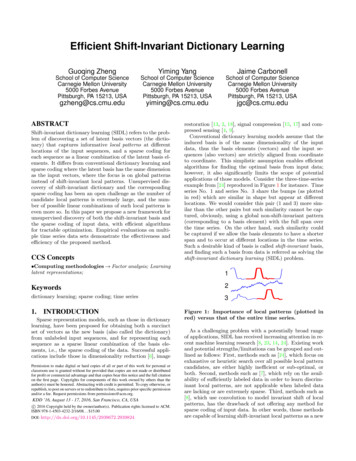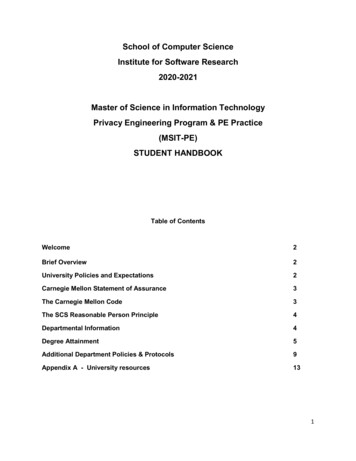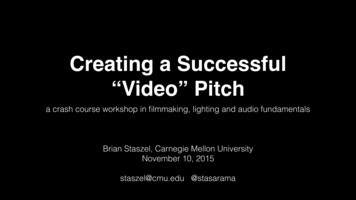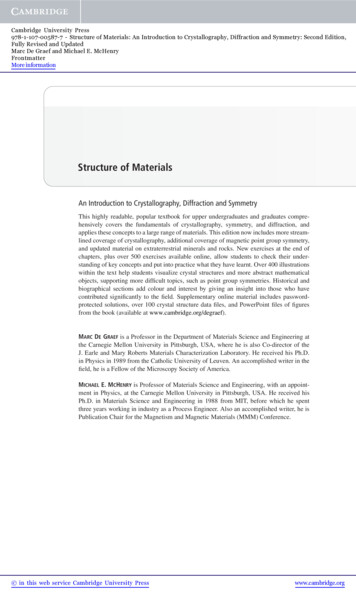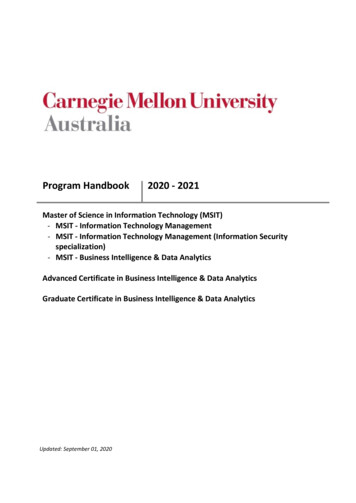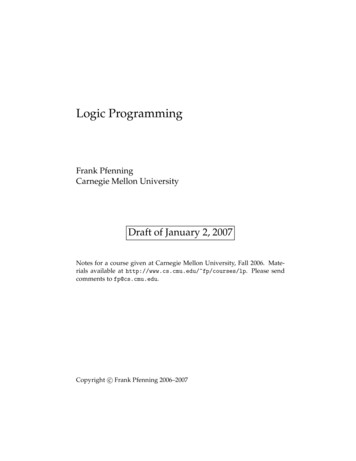
Transcription
Logic ProgrammingFrank PfenningCarnegie Mellon UniversityDraft of January 2, 2007Notes for a course given at Carnegie Mellon University, Fall 2006. Materials available at http://www.cs.cmu.edu/ fp/courses/lp. Please sendcomments to fp@cs.cmu.edu.Copyright c Frank Pfenning 2006–2007
L ECTURE N OTESJ ANUARY 2, 2007
15-819K: Logic ProgrammingLecture 1Logic ProgrammingFrank PfenningAugust 29, 2006In this first lecture we give a brief introduction to logic programming. Wealso discuss administrative details of the course, although these are notincluded here, but can be found on the course web page.11.1 Computation vs. DeductionLogic programming is a particular way to approach programming. Otherparadigms we might compare it to are imperative programming or functional programming. The divisions are not always clear-cut—a functionallanguage may have imperative aspects, for example—but the mindset ofvarious paradigms is quite different and determines how we design andreason about programs.To understand logic programming, we first examine the difference between computation and deduction. To compute we start from a given expression and, according to a fixed set of rules (the program) generatee aresult. For example, 15 26 (1 2 1)1 (3 1)1 41. To deducewe start from a conjecture and, according to a fixed set of rules (the axiomsand inference rules), try to construct a proof of the conjecture. So computation is mechanical and requires no ingenuity, while deduction is a creativeprocess. For example, an bn 6 cn for n 2, . . . 357 years of hard work . . .,QED.Philosophers, mathematicians, and computer scientists have tried tounify the two, or at least to understand the relationship between them forcenturies. For example, George Boole2 succeeded in reducing a certain class12http://www.cs.cmu.edu/ fp/courses/lp/1815–1864L ECTURE N OTESA UGUST 29, 2006
L1.2Logic Programmingof logical reasoning to computation in so-called Boolean algebras. Since thefundamental undecidability results of the 20th centuries we know that noteverything we can reason about is in fact mechanically computable, even ifwe follow a well-defined set of formal rules.In this course we are interested in a connection of a different kind. Afirst observation is that computation can be seen as a limited form of deduction because it establishes theorems. For example, 15 26 41 is boththe result of a computation, and a theorem of arithmetic. Conversely, deduction can be considered a form of computation if we fix a strategy forproof search, removing the guesswork (and the possibility of employingingenuity) from the deductive process.This latter idea is the foundation of logic programming. Logic programcomputation proceeds by proof search according to a fixed strategy. Byknowing what this strategy is, we can implement particular algorithms inlogic, and execute the algorithms by proof search.1.2 Judgments and ProofsSince logic programming computation is proof search, to study logic programming means to study proofs. We adopt here the approach by MartinLöf [3]. Although he studied logic as a basis for functional programmingrather than logic programming, his ideas are more fundamental and therefore equally applicable in both paradigms.The most basic notion is that of a judgment, which is an object of knowledge. We know a judgment because we have evidence for it. The kind ofevidence we are most interested in is a proof, which we display as a deduction using inference rules in the formJ1 . . . JnJRwhere R is the name of the rule (often omitted), J is the judgment established by the inference (the conclusion), and J1 , . . . , Jn are the premisses ofthe rule. We can read it asIf J1 and · · · and Jn then we can conclude J by virtue of rule R.By far the most common judgment is the truth of a proposition A, whichwe write as A true. Because we will be occupied almost exclusively withthe thruth of propositions for quite some time in this course we generallyomit the trailing “true”. Other examples of judgments on propositions areL ECTURE N OTESA UGUST 29, 2006
Logic ProgrammingL1.3A false (A is false), A true at t (A is true at time t, the subject of temporallogic), or K knows A (K knows that A is true, the subject of epistemic logic).To give some simple examples we need a language to express propositions. We start with terms t that have the form f (t1 , . . . , tn ) where f is afunction symbol of arity n and t1 , . . . , tn are the arguments. Terms can havevariables in them, which we generally denote by upper-case letters. Atomicpropositions P have the form p(t1 , . . . , tn ) where p is a predicate symbol of arity n and t1 , . . . , tn are its arguments. Later we will introduce more generalforms of propositions, built up by logical connectives and quantifiers fromatomic propositions.In our first set of examples we represent natural numbers 0, 1, 2, . . . asterms of the form z, s(z), s(s(z)), . . ., using two function symbols (z of arity0 and s of arity 1).3 The first predicate we consider is even of arity 1. Itsmeaning is defined by two inference rules:even(N )evzeven(s(s(N )))even(z)evsThe first rule, evz, expresses that 0 is even. It has no premiss and therefore islike an axiom. The second rule, evs, expresses that if N is even, then s(s(N ))is also even. Here, N is a schematic variable of the inference rule: everyinstance of the rule where N is replaced by a concrete term represents avalid inference. We have no more rules, so we think of these two as definingthe predicate even completely.The following is a trivial example of a deduction, showing that 4 is )))Here, we used the rule evs twice: once with N z and once with N s(s(z)).1.3 Proof SearchTo make the transition from inference rules to logic programming we needto impose a particular strategy. Two fundamental ideas suggest themselves: we could either search backward from the conjecture, growing a3This is not how numbers are represented in practical logic programming languagessuch as Prolog, but it is a convenient source of examples.L ECTURE N OTESA UGUST 29, 2006
L1.4Logic Programming(potential) proof tree upwards, or we could work forwards from the axioms applying rules until we arrive at the conjecture. We call the first onegoal-directed and the second one forward-reasoning. In the logic programming literature we find the terminology top-down for goal-directed, andbottom-up for forward-reasoning, but this goes counter to the direction inwhich the proof tree is constructed. Logic programming was conceivedwith goal-directed search, and this is still the dominant direction since itunderlies Prolog, the most popular logic programming language. Later inthe class, we will also have an opportunity to consider forward reasoning.In the first approximation, the goal-directed strategy we apply is verysimple: given a conjecture (called the goal) we determine which inferencerules might have been applied to arrive at this conclusion. We select one ofthem and then recursively apply our strategy to all the premisses as subgoals. If there are no premisses we have completed the proof of the goal.We will consider many refinements and more precise descriptions of searchin this course.For example, consider the conjecture even(s(s(z))). We now execute thelogic program consisting of the two rules evz and evs to either prove orrefute this goal. We notice that the only rule with a matching conclusion isevs. Our partial proof now looks like.even(z)evseven(s(s(z)))with even(z) as the only subgoal.Considering the subgoal even(z) we see that this time only the rule evzcould have this conclusion. Moreover, this rule has no premisses so thecomputation terminates successfully, having found the proofevzeven(z)evs.even(s(s(z)))Actually, most logic programming languages will not show the proof inthis situation, but only answer yes if a proof has been found, which meansthe conjecture was true.Now consider the goal even(s(s(s(z)))). Clearly, since 3 is not even, thecomputation must fail to produce a proof. Following our strategy, we firstL ECTURE N OTESA UGUST 29, 2006
Logic ProgrammingL1.5reduce this goal using the evs rule to the subgoal even(s(z)), with the incomplete proof.even(s(z))evs.even(s(s(s(z))))At this point we note that there is no rule whose conclusion matches thegoal even(s(z)). We say proof search fails, which will be reported back asthe result of the computation, usually by printing no.Since we think of the two rules as the complete definition of even weconclude that even(s(z)) is false. This example illustrates negation as failure,which is a common technique in logic programming. Notice, however, thatthere is an asymmetry: in the case where the conjecture was true, searchconstructed an explicit proof which provides evidence for its truth. In thecase where the conjecture was false, no evidence for its falsehood is immediately available. This means that negation does not have first-class statusin logic programming.1.4 Answer SubstitutionsIn the first example the response to a goal is either yes, in which case aproof has been found, or no, if all attempts at finding a proof fail finitely. Itis also possible that proof search does not terminate. But how can we writelogic programs to compute values?As an example we consider programs to compute sums and differencesof natural numbers in the representation from the previous section. Westart by specifying the underlying relation and then illustrate how it can beused for computation. The relation in this case is plus(m, n, p) which shouldhold if m n p. We use the recurrence(m 1) n (m n) 10 n nas our guide because it counts down the first argument to 0. We obtainplus(M, N, P )plus(s(M ), N, s(P ))pspz.plus(z, N, N )Now consider a goal of the form plus(s(z), s(z), R) where R is an unknown. This represents the question if there exists an R such that the relation plus(s(z), s(z), R) holds. Search not only constructs a proof, but also aterm t for R such that plus(s(z), s(z), t) is true.L ECTURE N OTESA UGUST 29, 2006
L1.6Logic ProgrammingFor the original goal, plus(s(z), s(z), R), only the rule ps could apply because of a mismatch between z and s(z) in the first argument to plus in theconclusion. We also see that the R must have the form s(P ) for some P ,although we do not know yet what P should be.plus(z, s(z), P )plus(s(z), s(z), R)ps with R s(P )For the subgoal only the pz rule applies and we see that P must equal s(z).plus(z, s(z), P )pz with P s(z)plus(s(z), s(z), R)ps with R s(P )If we carry out the substitutions we obtain the complete proofpzplus(z, s(z), s(z))psplus(s(z), s(z), s(s(z)))which is explicit evidence that 1 1 2. Instead of the full proof, implementations of logic programming languages mostly just print the substitution for the unknowns in the original goal, in this case R s(s(z)).Some terminology of logic programming: the original goal is called thequery, its unknowns are logic variables, and the result of the computation isan answer substitution for the logic variables, suppressing the proof.1.5 BacktrackingSometimes during proof search the goal matches the conclusion of morethan one rule. This is called a choice point. When we reach a choice point wepick the first among the rules that match, in the order they were presented.If that attempt at a proof fails, we try the second one that matches, and soon. This process is called backtracking.As an example, consider the query plus(M, s(z), s(s(z))), intended tocompute an m such that m 1 2, that is, m 2 1. This demonstrates that we can use the same logic program (here: the definition of theplus predicate) in different ways (before: addition, now: subtraction).L ECTURE N OTESA UGUST 29, 2006
Logic ProgrammingL1.7The conclusion of the rule pz, plus(z, N, N ), does not match because thesecond and third argument of the query are different. However, the rule psapplies and we obtain.plus(M1 , s(z), s(z))plus(M, s(z), s(s(z)))pswith M s(M1 )At this point both rules, ps and pz, match. Because the rule ps is listed first,leading to.plus(M2 , s(z), z)ps with M1 s(M2 )plus(M1 , s(z), s(z))ps with M s(M1 )plus(M, s(z), s(s(z)))At this point no rule applies at all and this attempt fails. So we return toour earlier choice point and try the second alternative, pz.plus(M1 , s(z), s(z))plus(M, s(z), s(s(z)))pzpswith M1 zwith M s(M1 )At this point the proof is complete, with the answer substitution M s(z).Note that with even a tiny bit of foresight we could have avoided thefailed attempt by picking the rule pz first. But even this small amount of ingenuity cannot be permitted: in order to have a satisfactory programminglanguage we must follow every step prescribed by the search strategy.1.6 Subgoal OrderAnother kind of choice arises when an inference rule has multiple premises,namely the order in which we try to find a proof for them. Of course, logically the order should not be relevant, but operationally the behavior of aprogram can be quite different.As an example, we define of times(m, n, p) which should hold if m n p. We implement the recurrence0 n 0(m 1) n (m n) nL ECTURE N OTESA UGUST 29, 2006
L1.8Logic Programmingin the form of the following two inference rules.times(z, N, z)times(M, N, P )tzplus(P, N, Q)tstimes(s(M ), N, Q)As an example we compute 1 2 Q. The first step is determined.times(z, s(s(z)), P ).plus(P, s(s(z)), Q)times(s(z), s(s(z)), Q)tsNow if we solve the left subgoal first, there is only one applicable rulewhich forces P ztimes(z, s(s(z)), P )ts (P z).plus(P, s(s(z)), Q)tstimes(s(z), s(s(z)), Q)Now since P z, there is only one rule that applies to the second subgoaland we obtain correctlytimes(z, s(s(z)), P )ts (P z)plus(P, s(s(z)), Q)pz (Q s(s(z)))ts.times(s(z), s(s(z)), Q)On the other hand, if we solve the right subgoal plus(P, s(s(z)), Q) firstwe have no information on P and Q, so both rules for plus apply. Since psis given first, the strategy discussed in the previous section means that wetry it first, which leads to.times(z, s(s(z)), P ).plus(P1 , s(s(z)), Q1 )plus(P, s(s(z)), Q)times(s(z), s(s(z)), Q)ps (P s(P1 ), Q s(Q1 )ts.Again, rules ps and ts are both applicable, with ps listed further, so weL ECTURE N OTESA UGUST 29, 2006
Logic ProgrammingL1.9continue:.plus(P2 , s(s(z)), Q2 ).times(z, s(s(z)), P )plus(P1 , s(s(z)), Q1 )plus(P, s(s(z)), Q)times(s(z), s(s(z)), Q)ps (P1 s(P2 ), Q1 s(Q2 ))ps (P s(P1 ), Q s(Q1 ))tsIt is easy to see that this will go on indefinitely, and computation will notterminate.This examples illustrate that the order in which subgoals are solved canhave a strong impact on the computation. Here, proof search either completes in two steps or does not terminate. This is a consequence of fixingan operational reading for the rules. The standard solution is to attack thesubgoals in left-to-right order. We observe here a common phenomenonof logic programming: two definitions, entirely equivalent from the logicalpoint of view, can be very different operationally. Actually, this is also truefor functional programming: two implementations of the same functioncan have very different complexity. This debunks the myth of “declarativeprogramming”—the idea that we only need to specify the problem ratherthan design and implement an algorithm for its solution. However, we canassert that both specification and implementation can be expressed in thelanguage of logic. As we will see later when we come to logical frameworks, we can integrate even correctness proofs into the same formalism!1.7 Prolog NotationBy far the most widely used logic programming language is Prolog, whichactually is a family of closely related languages. There are several goodtextbooks, language manuals, and language implementations, both freeand commercial. A good resource is the FAQ4 of the Prolog newsgroup5For this course we use GNU Prolog6 although the programs should run injust about any Prolog since we avoid the more advanced features.The two-dimensional presentation of inference rules does not lend itself4http://www.cs.kuleuven.ac.be/ olog/6http://gnu-prolog.inria.fr/5L ECTURE N OTESA UGUST 29, 2006
L1.10Logic Programmingto a textual format. The Prolog notation for a ruleJ1 . . . JnJRisJ J1 , . . . , Jn .where the name of the rule is omitted and the left-pointing arrow is rendered as ‘:-’ in a plain text file. We read this asJ if J1 and · · · and Jn .Prolog terminology for an inference rule is a clause, where J is the head ofthe clause and J1 , . . . , Jn is the body. Therefore, instead of saying that we“search for an inference rule whose conclusion matches the conjecture”, we saythat we “search for a clause whose head matches the goal”.As an example, we show the earlier programs in Prolog notation.even(z).even(s(s(N))) :- even(N).plus(s(M), N, s(P)) :- plus(M, N, P).plus(z, N, N).times(z, N, z).times(s(M), N, Q) :times(M, N, P),plus(P, N, Q).Clauses are tried in the order they are presented in the program. Subgoalsare solved in the order they are presented in the body of a clause.1.8 UnificationOne important operation during search is to determine if the conjecturematches the conclusion of an inference rule (or, in logic programming terminology, if the goal unifies with the head of a clause). This operation isa bit subtle, because the the rule may contain schematic variables, and thethe goal may also contain variables.As a simple example (which we glossed over before), consider the goalplus(s(z), s(z), R) and the clause plus(s(M ), N, s(P )) plus(M, N, P ). WeL ECTURE N OTESA UGUST 29, 2006
Logic ProgrammingL1.11need to find some way to instantiate M , N , and P in the clause head and Rin the goal such that plus(s(z), s(z), R) plus(s(M ), N, s(P )).Without formally describing an algorithm yet, the intuitive idea is tomatch up corresponding subterms. If one of them is a variable, we set itto the other term. Here we set M z, N s(z), and R s(P ). P isarbitrary and remains a variable. Applying these equations to the body ofthe clause we obtain plus(z, s(z), P ) which will be the subgoal with anotherlogic variable, P .In order to use the other clause for plus to solve this goal we have tosolve plus(z, s(z), P ) plus(z, N, N ) which sets N s(z) and P s(z).This process is called unification, and the equations for the variables wegenerate represent the unifier. There are some subtle issues in unification.One is that the variables in the clause (which really are schematic variablesin an inference rule) should be renamed to become fresh variables each timea clause is used so that the different instances of a rule are not confusedwith each other. Another issue is exemplified by the equation N s(s(N ))which does not have a solution: the right-hand side will have have twomore successors than the left-hand side so the two terms can never beequal. Unfortunately, Prolog does not properly account for this and treatssuch equations incorrectly by building a circular term (which is definitelynot a part of the underlying logical foundation). This could come up if wepose the query plus(z, N, s(N )): “Is there an n such that 0 n n 1.”We discuss the reasons for Prolog’s behavior later in this course (whichis related to efficiency), although we do not subscribe to it because it subverts the logical meaning of programs.1.9 Beyond PrologSince logic programming rests on an operational interpretation of logic, wemust study various logics as well as properties of proof search in theselogics in order to understand logic programming. We will therefore spenda fair amount of time in this course isolating logical principles. Only in thisway can we push the paradigm to its limits without departing too far fromwhat makes it beautiful: its elegant logical foundation.Roughly, we repeat the following steps multiple times in the course,culminating in an incredibly rich language that can express backtrackingsearch, concurrency, saturation, and even correctness proofs for many programs in a harmonious whole.1. Design a logic in a foundationally and philosophically sound manner.L ECTURE N OTESA UGUST 29, 2006
L1.12Logic Programming2. Isolate a fragment of the logic based on proof search criteria.3. Give an informal description of its operational behavior.4. Explore programming techniques and idioms.5. Formalize the operational semantics.6. Implement a high-level interpreter.7. Study properties of the language as a whole.8. Develop techniques for reasoning about individual programs.9. Identify limitations and consider how they might be addressed, eitherby logical or operational means.10. Go to step 1.Some of the logics we will definitely consider are intuitionistic logic,modal logic, higher-order logic, and linear logic, and possibly also temporal and epistemic logics. Ironically, even though logic programming derives from logic, the language we have considered so far (which is the basisof Prolog) does not require any logical connectives at all, just the mechanisms of judgments and inference rules.1.10 Historical NotesLogic programming and the Prolog language are credited to Alain Colmerauer and Robert Kowalski in the early 1970s. Colmerauer had been working on a specialized theorem prover for natural language processing, whicheventually evolved to a general purpose language called Prolog (for Programmation en Logique) that embodies the operational reading of clausesformulated by Kowalski. Interesting accounts of the birth of logic programming can be found in papers by the Colmerauer and Roussel [1] andKowalski [2].We like Sterling and Shapiro’s The Art of Prolog [4] as a good introductory textbook for those who already know how to program and we recommends O’Keefe’s The Craft of Prolog as a second book for those aspiring tobecome real Prolog hackers. Both of these are somewhat dated and do notcover many modern developments, which are the focus of this course. Wetherefore do not use them as textbooks here.L ECTURE N OTESA UGUST 29, 2006
Logic ProgrammingL1.131.11 ExercisesExercise 1.1 A different recurrence for addition is(m 1) n m (n 1)0 n nWrite logic programs for addition on numbers in unary notation based on thisrecurrence. What kind of query do we need to pose to compute differences correctly?Exercise 1.2 Determine if the times predicate can be used to calculate exact division, that is, given m and n find q such that m n q and fail if no such q exists.If not, give counterexamples for different ways that times could be invoked andwrite another program divexact to perform exact divison. Also write a program tocalculate both quotient and remainder of two numbers.Exercise 1.3 We saw that the plus predicate can be used to compute sums and differences. Find other creative uses for this predicate without writing any additionalcode.Exercise 1.4 Devise a representation of natural numbers in binary form as terms.Write logic programs to add and multiply binary numbers, and to translate between unary and binary numbers. Can you write a single relation that can beexecuted to translate in both directions?1.12 References[1] Alain Colmerauer and Philippe Roussel. The birth of Prolog. In Conference on the History of Programming Languages (HOPL-II), Preprints, pages37–52, Cambridge, Massachusetts, April 1993.[2] Robert A. Kowalski. The early years of logic programming. Communications of the ACM, 31(1):38–43, 1988.[3] Per Martin-Löf. On the meanings of the logical constants and the justifications of the logical laws. Nordic Journal of Philosophical Logic, 1(1):11–60, 1996.[4] Leon Sterling and Ehud Shapiro. The Art of Prolog. The MIT Press,Cambridge, Massachusetts, 2nd edition edition, 1994.L ECTURE N OTESA UGUST 29, 2006
L1.14L ECTURE N OTESLogic ProgrammingA UGUST 29, 2006
15-819K: Logic ProgrammingLecture 2Data StructuresFrank PfenningAugust 31, 2006In this second lecture we introduce some simple data structures such aslists, and simple algorithms on them such as as quicksort or mergesort.We also introduce some first considerations of types and modes for logicprograms.2.1 ListsLists are defined by two constructors: the empty list nil and the constructorcons which takes an element and a list, generating another list. For example, the list a, b, c would be represented as cons(a, cons(b, cons(c, nil))). Theofficial Prolog notation for nil is [], and for cons(h, t) is .(h, t), overloading the meaning of the period ‘.’ as a terminator for clauses and a binaryfunction symbol. In practice, however, this notation for cons is rarely used.Instead, most Prolog programs use [h t] for cons(h, t).There is also a sequence notation for lists, so that a, b, c can be written as [a, b, c]. It could also be written as [a [b [c []]]] or[a, b [c, []]]. Note that all of these notations will be parsed into thesame internal form, using nil and cons. We generally follow Prolog list notation in these notes.2.2 Type PredicatesWe now return to the definition of plus from the previous lecture, exceptthat we have reversed the order of the two clauses.plus(z, N, N).plus(s(M), N, s(P)) :- plus(M, N, P).L ECTURE N OTESA UGUST 31, 2006
L2.2Data StructuresIn view of the new list constructors for terms, the first clause now lookswrong. For example, with this clause we can proveplus(s(z), [a, b, c], s([a, b, c])).This is absurd: what does it mean to add 1 and a list? What does the terms([a, b, c]) denote? It is clearly neither a list nor a number.From the modern programming language perspective the answer isclear: the definition above lacks types. Unfortunately, Prolog (and traditional predicate calculus from which it was originally derived) do not distinguish terms of different types. The historical answer for why these languages have just a single type of terms is that types can be defined as unarypredicates. While this is true, it does not account for the pragmatic advantage of distinguishing meaningful propositions from those that are not. Toillustrate this, the standard means to correct the example above would beto define a predicate nat with the rulesnznat(z)nat(N )nat(s(N ))nsand modify the base case of the rules for additionnat(N )pzplus(z, N, N )plus(M, N, P )psplus(s(M ), N, s(P ))One of the problems is that now, for example, plus(z, nil, nil) is false, when itshould actually be meaningless. Many problems in debugging Prolog programs can be traced to the fact that propositions that should be meaninglesswill be interpreted as either true or false instead, incorrectly succeeding orfailing. If we transliterate the above into Prolog, we get:nat(z).nat(s(N)) :- nat(N).plus(z, N, N) :- nat(N).plus(s(M), N, s(P)) :- plus(M, N, P).No self-respecting Prolog programmer would write the plus predicate thisway. Instead, he or she would omit the type test in the first clause leadingto the earlier program. The main difference between the two is whethermeaningless clauses are false (with the type test) or true (without the typetest). One should then annotate the predicate with the intended domain.L ECTURE N OTESA UGUST 31, 2006
Data StructuresL2.3% plus(m, n, p) iff m n p for nat numbers m, n, p.plus(z, N, N).plus(s(M), N, s(P)) :- plus(M, N, P).It would be much preferable from the programmer’s standpoint if thisinformal comment were a formal type declaration, and an illegal invocationof plus were a compile-time error rather than leading to silent success orfailure. There has been some significant research on types systems and typechecking for logic programming languages [5] and we will talk about typesmore later in this course.2.3 List TypesWe begin with the type predicates defining lists.list([]).list([X Xs]) :- list(Xs).Unlike languages such as ML, there is no test whether the elements of a listall have the same type. We could easily test whether something is a list ofnatural numbers.natlist([]).natlist([N Ns]) :- nat(N), natlist(Ns).The generic test, whether we are presented with a homogeneous list, all ofwhose elements satisfy some predicate P, would be written as:plist(P, []).plist(P, [X Xs]) :- P(X), plist(P, Xs).While this is legal in some Prolog implementations, it can not be justifiedfrom the underlying logical foundation, because P stands for a predicateand is an argument to another predicate, plist. This is the realm of higherorder logic, and a proper study of it requires a development of higher-orderlogic programming [3, 4]. In Prolog the goal P(X) is a meta-call, often writtenas call(P(X)). We will avoid its use, unless we develop higher-order logicprogramming later in this course.2.4 List Membership and DisequalityAs a second example, we consider membership of an element in a list.member(X, Y s)member(X, cons(X, Y s))L ECTURE N OTESmember(X, cons(Y, Y s))A UGUST 31, 2006
L2.4Data StructuresIn Prolog syntax:% member(X, Ys) iff X is a member of list Ysmember(X, [X Ys]).member(X, [Y Ys]) :- member(X, Ys).Note that in the first clause we have omitted the check whether Ys is aproper list, making it part of the presupposition that the second argumentto member is a list.Already, this very simple predicate has some subtle points. To showthe examples, we use the Prolog notation ?- A. for a query A. After presenting the first answer substitution, Prolog interpreters issue a prompt tosee if another solution is desired. If the user types ‘;’ the interpreter willbacktrack to see if another solution can be found. For example, the query?- member(X, [a,b,a,c]).has four solutions, in the orderXXXX a;b;a;c.Perhaps surprisingly, the query?- member(a, [a,b,a,c]).succeeds twice (both with the empty substitution), once for the first occurrence of a and once for the second occurrence.If member is part of a larger program, backtracking of a later goal couldlead to unexpected surp
Logic Programming Frank Pfenning August 29, 2006 In this first lecture we give a brief introduction to logic programming. We also discuss administrative details of the course, although these are not included here, but can be found on the course web page.1 1.1 Computation vs. Deduction Logic
